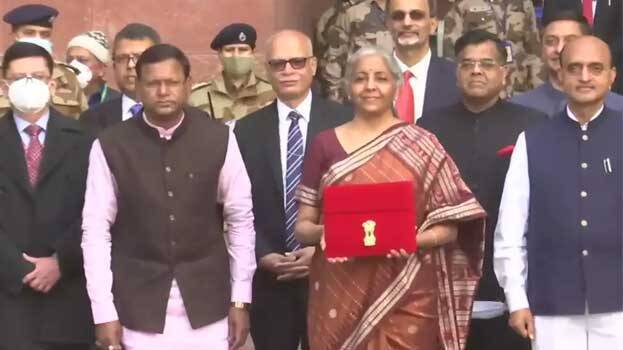Budget 2022-23 – Spotlight Of Budget On Climate Change
For the first, Union Budget acknowledges climate action in it’s opening statement

The Union Budget 2022-23 acknowledges clean energy transition as a fundamental principle- there was mention of clean tech solutions, battery swapping policies, improving EV efficiency, finalising the 19500 cr PLI scheme for solar as a way to move ahead on low Carbon strategy.
While jargon terms such as Energy Transition, Climate Finance, Inclusive Growth etc. were mentioned multiple times in the budget speech today bringing spotlight on climate change and actions related to it.
By fundamentally focusing on clean and sustainable development, the budget has focused on three major sectors: transport, energy and agriculture with an aim to reduce both reductions in CO2 and air pollution emissions which augur well for clean air programs in the short term and achieving Carbon neutrality in the long term.
By referring to climate action as a sunrise sector and employment generator, Budget 2022 has sent an important signal to markets, financial institutions and the workforce. The support for natural farming, and broadly sustainable agriculture, is a welcome move.The budget proposal to issue sovereign green bonds has several benefits, principal among which is signalling the country’s seriousness in pursuing climate action. India will now join a select group of countries, primarily European, which have issued such bonds.
The increase of Rs19500 crore under the PLI scheme for high efficiency modules and the inclusion of a #zerofossilfuel policy, #EVpolicy, #batteryswapping and #coalgasification policy is a step in the right direction.
The Budget emphasised that private capital will play a pivotal role. Further, the launching of sovereign green bonds will help reduce the carbon intensity of the economy and will enable access to a large pool of money for the energy transition.
India has set up a huge target of 500GW of non fossil fuel energy by 2030. While renewable energy is competitive, the new technologies will require support. The Government should have provided a budget allocation and reduction of duties to allow the deployment of rooftop solar, storage, off-shore wind, green hydrogen etc. Further, the Budget didn’t include any mention of support for the closure of inefficient fossil fuel plants, nor did it deal with increasing air pollution problems.
We now need the power of government incentives, aggregation and de-risking for clean energy to be complemented by standards for low-carbon materials, skilling for battery recycling, and consultative processes for green infrastructure projects. Biomass pellets, energy efficient buildings, coal gasification and agroforestry are just the start of the transition to a carbon-neutral economy. The upcoming green hydrogen mission and circular economy action plans can initiate a deep shift towards industrial decarbonization.
India has set up a huge target of 500GW of non fossil fuel energy by 2030.
While renewable energy is competitive, the new technologies will require support. The Government should have provided a budget allocation and reduction of duties to allow the deployment of rooftop solar, storage, off-shore wind, green hydrogen etc. Further, the Budget didn’t include any mention of support for the closure of inefficient fossil fuel plants, nor did it deal with increasing air pollution problems. Energy storage systems as the one critical technology which needs innovation, finance and regulation got attention in the budget.
Aarti Khosla, Director, Climate Trends commenting on Budget said “The Finance Minister mentioned explicitly that climate risk is among the strongest negative externalities. So far this has been a strong acknowledgement and case for climate action. Devil lies in details and the industry will be hoping for more policy and investment details to see if the private sector is meant to take the lead in energy transition. The mention of green bonds as part of overall market borrowings is a good step to raise funds for projects ear marked as green infrastructure. Proceeds will be deployed in public sector projects which also reduce emissions”.
Abhishek Jain, Fellow and Director – Powering Livelihoods, Council on Energy, Environment and Water (CEEW) said “The support for natural farming, and broadly sustainable agriculture, is a welcome move. While the thrust is going to be around the river Ganga, the government must also focus on the rain fed areas in particular. These areas are home to 50% of Indian farmers and they primarily stand to gain by shifting to natural farming. The government should consider an automatic enrolment of farmers practising Natural Farming into the Pradhan Mantri Fasal Bima Yojana to provide a safety net and encourage more farmers to transition to sustainable agriculture.”
Dr. Anjal Prakash, Research Director and adjunct associate professor at the Bharti Institute of Public Policy, Indian School of Business, lead author of the chapter on cities, settlements, and critical infrastructure and a cross-chapter paper on mountains as part of IPCC’s 6th assessment cycle, said “For climate action, this budget fairs quite well. The focus on sustainable urban planning and mass transport is a welcome step. It is estimated that half of Indians will be living in urban areas by 2050. The high-level committee of urban planners, economists and setting up institutions for capacity building is a welcome step. I hope that the planners will recommend urban infrastructure to be climate-resilient as many Indian cities are prone to climate-related risks and disasters”.
Announcing a climate action fund is a welcome step where the government’s share maximum of 20% and the rest is by the private parties. The Green Bonds for mobilising green infrastructure will be used for projects that will help reduce India’s carbon intensity. The allocation for renewable energy and energy storage technologies such as solar modules are another area that needs applause. The major miss is focusing on the river linking project and budget allocations. Each river originates and flows in particular ecological conditions. Rather than helping to fix the ecological balance of the watershed where the river starts and flows, the focus is on the linking of rivers. This would be an environmental disaster and not a piece of good news for climate action.
On Green Bonds-Madhav Pai, Executive Director, WRI India Ross Center said “There is a need to create a pipeline of bankable projects that can be funded by green bonds. This is a great opportunity for MoHUA to set up a project preparation facility around topics of water, sewerage, storm water, sanitation and transport”.
Chirag Gajjar, Head, Subnational Climate Action, Climate Program, WRI India said “Announcement of PM Gati Shakti master plan is a step in the direction toward a cleaner transport sector. As the transport demand for passengers and freight movement is likely to double over this decade, the ‘seven engines’ of the master plan can enable integration of multi-modes leading to reduced emissions”.
Nitish Arora, Lead – Electric Mobility and Clean Energy, NRDC said “Clean energy powered electric transportation remains critical for meeting India’s climate targets. Union budget 2022 makes a big push towards mainstreaming electric mobility by providing for battery swapping policy, special mobility zones for EVs, augmenting charging infrastructure, ratifying building bye laws, clean tech in public transport and much more. Indeed, it marks a drive in the right direction”.
Gagan Sidhu, Director, CEEW Centre for Energy Finance (CEEW-CEF) said “The budget proposal to issue sovereign green bonds has several benefits, principal among which is signalling the country’s seriousness in pursuing climate action. India will now join a select group of countries, primarily European, which have issued such bonds. We can also expect this move to catalyse the development of the domestic corporate green bond market. Green bond issuances by Indian companies in the overseas debt capital markets have considerably lagged so far. If sovereign green bonds price at lower yields versus their non-green counterparts, it will also provide an added signal for the private sector to direct their own capital towards green investments. This important move also ties in with the capital expenditure push – a key feature of this budget – and cuts across two of the four pillars that the Finance Minister highlighted in the budget speech: Energy Transition and Climate Action, and Financing of Investments.”
Rishabh Jain, Programme Lead, CEEW Centre for Energy Finance (CEEW-CEF) said “While India has been highly dependent on imports to meet the requirements of solar modules, the announcement of an additional INR 19,500 crores (total 24,000 crores) for high-efficiency solar module manufacturing will encourage many existing and potential manufacturers to set up integrated manufacturing in India. This PLI scheme, along with basic customs duty on solar modules and extension of concessional tax regime (15%) for manufacturing (until March 2024), could be the key catalyst for India to become a global manufacturing and R&D hub for solar modules and associated products. Further, scaling up domestic manufacturing would create new jobs, reduce forex outflow and shield India from global supply chain shocks. India has no experience in polysilicon and wafer manufacturing and limited experience in solar cell manufacturing. To leverage this opportunity, manufacturers would need to invest significantly in upskilling manpower and R&D. Institutes of higher education would also need to align their courses to match the skill requirements of the industry.”
The writer of this article is Dr. Seema Javed, a known Environmentalist, Journalist and Communications Expert




